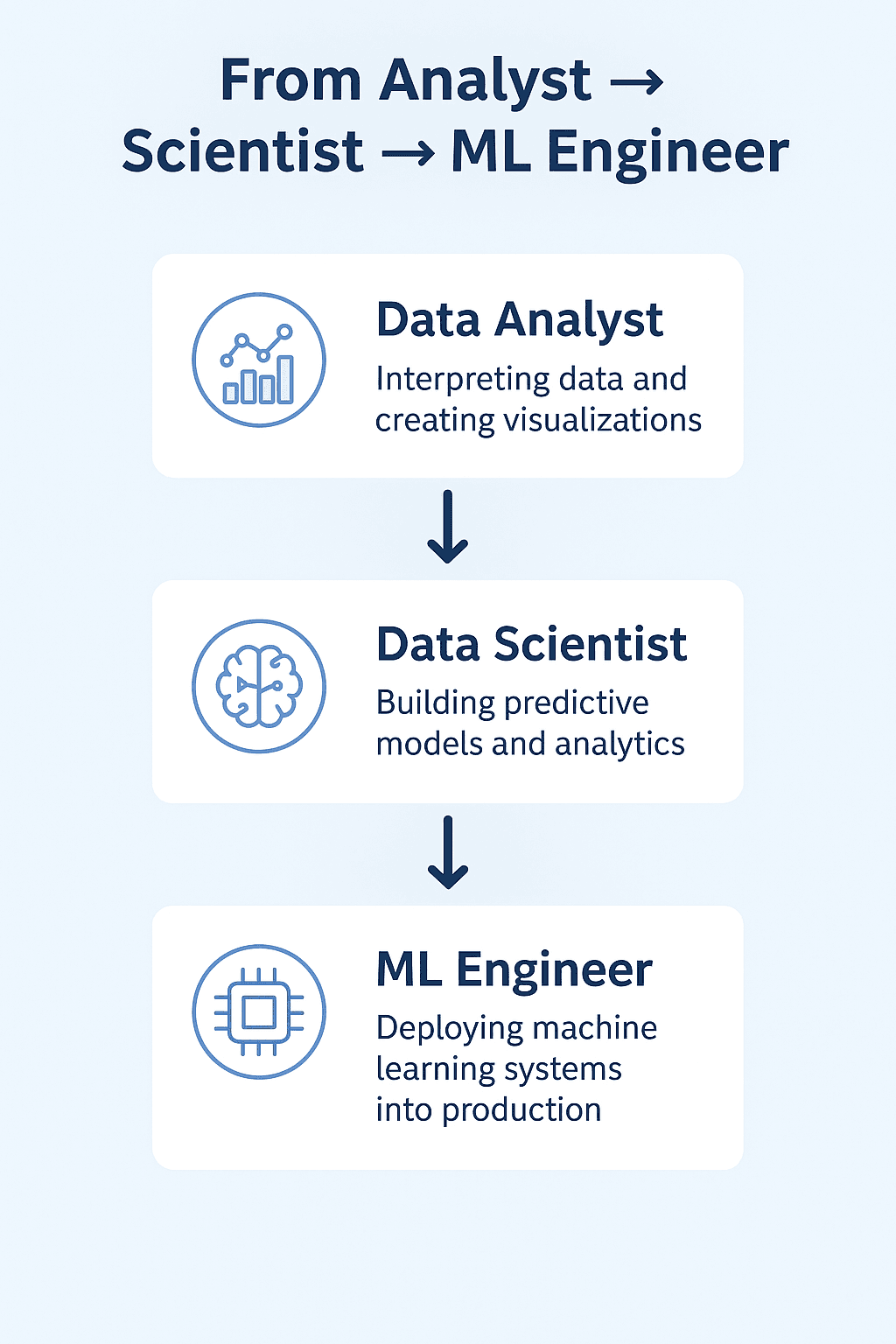Are you confused about the differences among Data Scientist Vs Data Analyst Vs ML Engineer? Examine major differences in skills, responsibilities, salaries, and professional advancement to determine the best path in data science.
Job titles such as Data Analyst, Data Scientist, and Machine Learning (ML) Engineer are frequently used interchangeably in today’s data-driven society. However, each position has unique duties, necessary abilities, and career pathways.
Clarity regarding these responsibilities is crucial for professionals seeking to upskill, career switchers hoping to get into the tech industry, and students choosing their educational path.
Without this clarity, one may wind up pursuing employment, qualifications, or even courses that aren’t in line with long-term objectives. You can develop abilities that are actually in demand and make better career options if you are aware of the main distinctions and similarities among these three roles.
In this article, I will clarify this for you by presenting a detailed comparison among data analyst, data scientist, and machine learning engineer roles. By the end of this guide, you will understand the key differences among these job positions and can make better career decisions.
Here is a brief overview that contrasts the three roles to set the scene:
Data Analyst vs. Data Scientist vs. ML Engineer – Snapshot
| Aspect | Data Analyst | Data Scientist | ML Engineer |
|---|---|---|---|
| Primary Focus | Interpreting and visualizing data | Building models to generate insights and predictions | Designing & deploying ML systems into production |
| Key Tools | Excel, SQL, Power BI, Tableau | Python, R, Jupyter, ML libraries | Python, TensorFlow, PyTorch, cloud platforms |
| Main Output | Dashboards, reports, business insights | Predictive models, advanced analytics | Scalable AI applications & ML pipelines |
| Math/Stat Level | Moderate | High | Very High |
| Coding Skills | Basic to intermediate | Advanced | Expert-level |
| Career Goal | Support decision-making | Drive data strategy & innovation | Build production-grade AI solutions |
Data Analyst Vs Data Scientist Vs ML Engineer
What Does a Data Analyst Do?
A data analyst is the expert who connects unprocessed data with business decisions. Their primary responsibility is to gather, purify, evaluate, and present data so that businesses may make wise decisions.
Data analysts are more concerned with converting numbers into understandable, actionable insights than data scientists or machine learning developers are with sophisticated modeling.
Consider them to be the storytellers of data; they find correlations, trends, and patterns that help company executives with operations, strategy, and expansion.

Key Responsibilities of a Data Analyst
A Data Analyst’s work usually revolves around:
- Data Cleaning & Preparation: Ensuring datasets are accurate, consistent, and useful.
- Exploratory Data Analysis (EDA): Identifying patterns, anomalies, and insights from data.
- Visualization & Reporting: Making dashboards, charts, and presentations using tools like Tableau, Power BI, or Excel.
- Business Insights: Translating complex data into recommendations that non-technical stakeholders can understand.
- Ad-hoc Queries: Using SQL or similar tools to quickly answer business questions.
Essential Skills for a Data Analyst
- Technical Tools: SQL, Excel, Power BI, Tableau, Google Data Studio (Looker Studio).
- Programming Basics: Some analysts use Python (Pandas, Matplotlib) or R for more advanced analysis.
- Statistics & Math: A strong grasp of descriptive stats (averages, variances, correlations) and hypothesis testing.
- Business Acumen: Ability to understand the domain (finance, healthcare, retail, etc.) and connect numbers to real outcomes.
- Communication Skills: Turning complex data into simple, clear stories that influence decision-making.
Typical Industries and Projects
Data Analysts are needed in almost every industry. Some common examples are as follows:
- Finance & Banking → Risk analysis, fraud detection, investment performance reports.
- Healthcare → Patient outcomes analysis, hospital performance dashboards.
- Retail & E-commerce → Customer purchase trends, product demand forecasting.
- Marketing → Campaign performance analysis, customer segmentation.
- Government & Public Policy → Population studies, social program effectiveness reports.
Average Salary Trends
Salaries for Data Analysts vary by location, experience, and industry:
- United States: $60,000 – $85,000 annually (Glassdoor, 2025).
- India: ₹5 – 10 LPA for mid-level professionals (Naukri, 2025).
- Europe (UK, Germany, Netherlands): €40,000 – €65,000 annually.
Although they usually begin lower, entry-level analysts can advance to business intelligence or senior analyst positions with experience.
Data Analysts are the foundation of the data profession. While they don’t always create prediction models or implement AI systems, they do make data comprehensible, trustworthy, and useful—skills that are highly valued in a variety of industries.
What Does a Data Scientist Do?
The “problem-solver” of the data world is frequently viewed as a data scientist. While data scientists utilize sophisticated statistics, machine learning, and programming to forecast future events and create clever solutions, data analysts concentrate on descriptive insights (what happened and why).
To put it simply, the role of a data scientist is to identify patterns in big, complicated datasets and turn them into models that inform creative products or corporate strategies.

Key Responsibilities of a Data Scientist
- Data Collection & Preparation: Working with structured and unstructured data from multiple sources.
- Advanced Analytics: Using statistical methods to uncover deep insights.
- Predictive Modeling: Building models that forecast trends, behaviors, or risks.
- Machine Learning (ML) Model Development: Training and testing ML algorithms for classification, regression, clustering, and recommendation systems.
- Big Data Processing: Handling huge datasets using frameworks like Hadoop, Spark, or cloud-based platforms.
- Experimentation: Designing and conducting A/B tests and simulations to validate models.
- Communication: Presenting insights and model results to both technical teams and non-technical stakeholders.
Key Skills for a Data Scientist
- Programming: Proficiency in Python and R (using libraries like Pandas, NumPy, Scikit-learn, Statsmodels).
- Mathematics & Statistics: Strong foundation in probability, linear algebra, calculus, and statistical modeling.
- Machine Learning: Understanding supervised, unsupervised, and deep learning algorithms.
- Big Data & Cloud: Familiarity with Spark, Hadoop, AWS, GCP, Azure.
- Data Visualization: Tools like Matplotlib, Seaborn, Plotly, or Tableau.
- Soft Skills: Critical thinking, domain knowledge, and storytelling with data.
Tools Commonly Used by Data Scientists
- Development Environments: Jupyter Notebook, RStudio, VS Code.
- Machine Learning Frameworks: TensorFlow, PyTorch, Scikit-learn, XGBoost.
- Big Data Tools: Apache Spark, Hadoop.
- Database Tools: SQL, NoSQL (MongoDB, Cassandra).
- Visualization Tools: Tableau, Power BI, or open-source libraries.
Industries Hiring Data Scientists
Demand for data science is high throughout industries, particularly in areas with large and complicated data sets.
- Technology & AI → Personalization engines, recommendation systems (e.g., Netflix, Amazon).
- Healthcare → Predictive diagnostics, drug discovery, patient risk prediction.
- Finance → Algorithmic trading, credit scoring, fraud detection.
- Retail & E-commerce → Demand forecasting, personalized marketing, customer behavior prediction.
- Transportation & Logistics → Route optimization, predictive maintenance.
- Government & Research → Climate modeling, census analysis, public safety insights.
Average Salary Comparison
Data Scientists generally earn more than Data Analysts, due to the complexity of their role.
- United States: $100,000 – $135,000 annually (Glassdoor, 2025).
- India: ₹10 – 18 LPA mid-level average (Naukri & AmbitionBox, 2025).
- Europe (UK, Germany, Netherlands): €55,000 – €85,000 annually.
With experience, many data scientists progress into Senior Data Scientist, Lead Data Scientist, or AI Specialist roles.
The data ecosystem’s innovation is driven by data scientists. Using sophisticated modeling to inform company strategies and develop AI-powered solutions, they do more than just examine the past; they also forecast the future.
What Does a Machine Learning Engineer Do?
It is the expertise of a Machine Learning Engineer (ML Engineer) to take machine learning models from research notebooks and implement them in practical applications.
While data scientists create and test models, machine learning engineers make sure such models are effective, scalable, and ready for production.
Recommendation engines, voice assistants, fraud detection tools, and other AI systems are powered by a combination of software engineering, machine learning, and cloud technology skills.
Building and maintaining intelligent systems is essentially the responsibility of ML engineers.

Key Responsibilities of a Machine Learning Engineer
- Model Deployment: Taking trained ML models and integrating them into production systems.
- MLOps (Machine Learning Operations): Automating model training, testing, monitoring, and updating to ensure reliability.
- Scalability: Designing systems that handle massive data loads and real-time processing.
- Automation: Streamlining workflows, from data pipelines to retraining models.
- Collaboration: Working with data scientists to translate research models into robust code, and with software engineers to integrate models into applications.
- Monitoring & Optimization: Tracking performance of deployed models and updating them when accuracy drops.
Skills Needed for ML Engineers
- Deep Learning & ML Knowledge: Understanding algorithms, neural networks, NLP, and computer vision.
- Programming & Software Engineering: Advanced Python, C++, Java, plus strong coding practices.
- APIs & Integration: Building REST APIs or gRPC services to make ML models accessible to applications.
- Cloud Platforms: Expertise in AWS SageMaker, Google Vertex AI, and Azure ML.
- MLOps & DevOps: Familiarity with Docker, Kubernetes, CI/CD pipelines, Git, MLflow.
- Data Engineering: Skills in handling large-scale data pipelines using Apache Spark, Kafka, and Airflow.
Tools Commonly Used by ML Engineers
- ML Frameworks: TensorFlow, PyTorch, Scikit-learn.
- Deployment & Orchestration: Docker, Kubernetes, Airflow, MLflow.
- Cloud Services: AWS SageMaker, GCP Vertex AI, Azure ML Studio.
- Data Handling: Spark, Hadoop, SQL, NoSQL databases.
- Monitoring Tools: Prometheus, Grafana for system and model monitoring.
Industries and Projects for ML Engineers
ML engineers are in great demand in fields that depend on automation and personalization powered by AI.
- Tech & Internet → Recommendation systems (YouTube, Netflix), search optimization, ad targeting.
- Finance → Fraud detection, credit risk modeling, algorithmic trading.
- Healthcare → Medical image analysis, real-time diagnostics, personalized treatments.
- Automotive → Self-driving car systems, predictive maintenance.
- Manufacturing & IoT → Predictive analytics, robotics, smart factories.
- Cybersecurity → Anomaly detection, intrusion prevention systems.
Salary Benchmarks
Because of their extensive technical knowledge and the need for production-grade AI, ML engineers sometimes command wages that are comparable to or higher than those of data scientists.
- United States: $115,000 – $150,000 annually (Indeed & Glassdoor, 2025).
- India: ₹12 – 20 LPA for mid-level professionals (Naukri, 2025).
- Europe (UK, Germany, Netherlands): €60,000 – €95,000 annually.
Machine Learning Engineers are AI developers who turn experimental models into real-world applications. If Data Scientists are the architects of machine learning, ML Engineers are the construction workers who ensure those designs execute smoothly at scale.
With seniority, ML Engineers can advance to become AI Architects, ML Engineering Managers, or Heads of AI Infrastructure.
Data Scientist vs Data Analyst vs ML Engineer: Key Differences
These three positions are frequently viewed as belonging to a spectrum of data-related jobs, ranging from interpreting data (Data Analyst), to experimenting and developing with data (Data Scientist), to developing AI systems on a large scale (ML Engineer).
Here is a thorough comparison table that outlines the main distinctions.
Detailed Comparison Table
| Aspect | Data Analyst | Data Scientist | ML Engineer |
| Focus Area | Interpreting and visualizing historical data to support decisions | Advanced analytics, building predictive & ML models for insights | Deploying and scaling ML models into production systems |
| Skills Required | SQL, Excel, Tableau/Power BI, basic Python or R, statistics | Python or R, ML algorithms, advanced statistics, data wrangling, big data | Deep learning, software engineering, APIs, MLOps, cloud platforms |
| Tools Used | Excel, SQL, Tableau, Power BI, Google Data Studio | Jupyter, RStudio, TensorFlow, PyTorch, Spark, Scikit-learn | TensorFlow, PyTorch, AWS SageMaker, GCP Vertex AI, Docker, Kubernetes |
| Educational Background | Bachelor’s in Business, Economics, Statistics, or Computer Science | Master’s or PhD in Data Science, Computer Science, Statistics, or related field | Strong CS/Engineering background, often Master’s in AI/ML or equivalent hands-on experience |
| Salary Range (Avg.) | US: $60K–$85K / India: ₹5–10 LPA | US: $100K–$135K / India: ₹10–18 LPA | US: $115K–$150K / India: ₹12–20 LPA |
| Career Growth | Senior Analyst → BI Specialist → Data Analytics Manager | Senior Data Scientist → Lead Data Scientist → AI/ML Researcher | Senior ML Engineer → AI Architect → Head of ML/AI Infrastructure |

Career Transition
Can a Data Analyst Become a Data Scientist?
In reality, a lot of data scientists begin their careers as data analysts. The next stage is to develop strong programming (Python or R), statistical modeling, and machine learning skills because analysts already understand business data, reporting, and visualization.
The transition focus is on going from descriptive analytics, which focuses on what happened, to predictive modeling, which focuses on what will happen.
Can a Data Scientist Transition to ML Engineer?
Yes, however, more software engineering and MLOps skills are needed for this route. ML engineers install models, whereas data scientists construct them. A data scientist must concentrate on scalability, automation, APIs, and cloud deployment in order to close the gap.
Moving from experimentation to production systems is the transition focus.
Summary & Final Thoughts
Selecting the “best” role among data scientist, machine learning engineer, and data analyst is not the point. Finding the one that fits your interests, abilities, and professional objectives is more important.
The Data Analyst career path can be a good option for you if you like building dashboards, visualizing data, and assisting companies in making decisions. The storytellers who make incomprehensible raw numbers are analysts.
The position of data scientist can be ideal for you if you’re interested in algorithms, predictive modeling, and finding hidden patterns in data. Solving challenging issues and fostering creativity are what data scientists are all about.
A career as a machine learning engineer can be your calling if you enjoy software engineering, creating scalable systems, and integrating AI into applications. ML engineers guarantee that AI models function at scale in addition to in theory.
To summarize the contrasts: While ML engineers concentrate on automation and production, analysts concentrate on descriptive insights, and scientists on predictive and prescriptive modeling. Every role contributes something special and worthwhile to the data environment.
Ask yourself if you like using facts to tell tales when making your decision. Is solving mathematical puzzles something I enjoy? Or am I a system builder and engineer by nature? Your responses may be able to point you in the correct direction.
One thing is true regardless of the role that interests you: lifelong learning is crucial. Upskilling via online courses, certifications, and practical projects is necessary to stay current with the rapid evolution of data and AI.
Start with what you already know, gradually learn new skills, and never stop exploring. Regardless of your career path—data scientist, data analyst, or machine learning engineer—you will be essential in determining how a data-driven world develops in the future.
FAQ
Is a Data Scientist higher than a Data Analyst?
Yes, a data scientist is typically seen as having a higher level of expertise than a data analyst. Data scientists create prediction models, use machine learning, and deal with more complicated data issues, whereas analysts concentrate on reporting, dashboards, and descriptive analytics. Higher pay and more possibilities for advancement are frequently associated with this increased level of responsibility and necessary knowledge.
Do ML Engineers earn more than Data Scientists?
Particularly in the US and Europe, machine learning engineers frequently make a little more money than data scientists. This is due to the fact that ML engineers possess the software engineering and MLOps abilities necessary to implement those models in production, in addition to their understanding of data and models. Because businesses appreciate their capacity to scale AI systems, ML engineers are in high demand and receive competitive pay.
Which role is best for freshers?
The Data Analyst position is typically the best place for new hires or entry-level employees to start. It doesn’t immediately require sophisticated machine learning or cloud engineering abilities, but it does require a strong foundation in SQL, Excel, and visualization tools. Many new hires start out as analysts, learn about the field, and eventually advance into roles as data scientists or machine learning engineers.
Can I switch from Data Analyst to ML Engineer?
It’s a multi-step process, but it is achievable. The majority of analysts first advance into data science by honing their machine learning, statistics, and Python or R skills. Software engineering, APIs, cloud platforms, and MLOps tools like Docker and Kubernetes must then be mastered in order to advance into an ML Engineer position. With concentrated study and practical projects, many professionals effectively navigate this change, despite the fact that it takes time.
Share Now
Discover more from coursekart.online
Subscribe to get the latest posts sent to your email.

